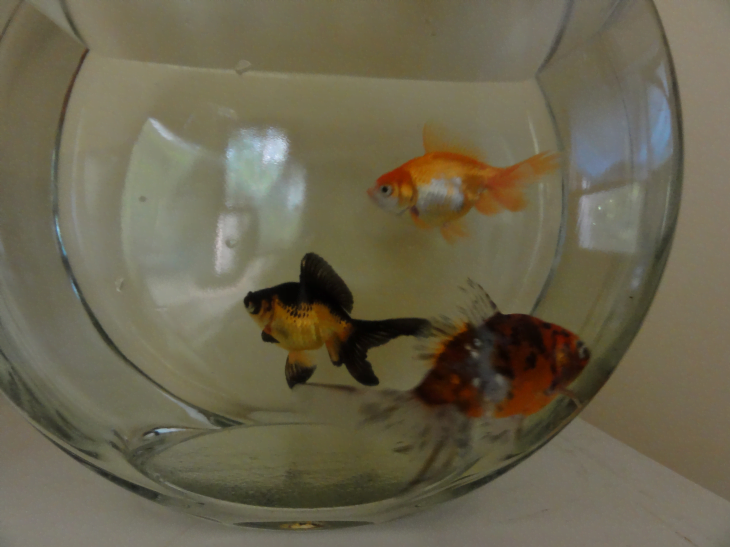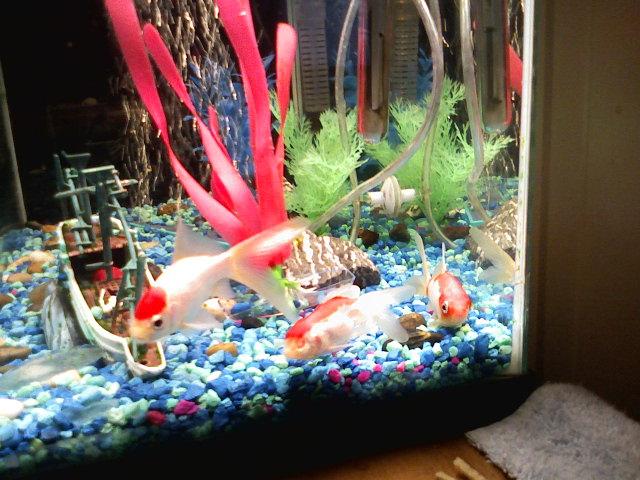What kind of goldfish house is right for you and your fish?
STEP 1
Goldfish Koi House can be any container that’s clean, appropriately sized and strong enough to hold water. What size goldfish house do your fish need? Goldfish average 16 years living in a healthy environment, however, some live for much longer, growing much larger. Start with a goldfish house adequately sized. Goldfish will easily reach 2″ their first year, averaging 1″ per year
Recommended STOCKING LEVEL 2.5 gallons of water per 1″ of body
Recommended water minimum DEPTH; body length of largest fish from nose to tail base
Koi grow three times as large, requiring three times the space
Size fish house appropriately, so that water parameters remain consistent. With proper care and proper housing a common goldfish could easily out live your dog or cat
Goldfish Housing
There are many styles and sizes of aquariums on the market today, however, keep in mind when choosing a fish house that goldfish require less depth and more surface area. The majority of aquariums are designed for tropical fish; not goldfish
Goldfish houses with small surface area compared to the body of water need increased water movement.
Depth of water should not be less than the length of the longest fish from nose to tail
- Suitable tank mates for goldfish
Separate the smallest fish from the largest. Goldfish are omnivorous. They will eat anything that fits in their mouth, including other goldfish. The same holds true with Koi. Even though these fish form attachments to other fish, their natural instinct to survive in the wild drives them to nibble at anything and everything. They just can’t help themselves
Goldfish care
Goldfish have been known to jump out of their water. Avoid accidents by lowering the water table. The gap between the surface and the top should match the body length of your longest fish, and yet another reason to have a larger container for your goldfish. Most aquariums come equipped with lids, however, goldfish fare much better in open topped tanks with the water surface exposed to fresh air. If you feel more comfortable with a top consider a screen
Goldfish keeping
It’s fun to play around in your tank or pond. It’s hard to resist beautiful decorations, and sometimes we have a tendency to overdo it. Make certain that the decorations you place in your goldfish house are aquarium safe before adding. If quarters are tight make sure that the object is not taking up valuable space the goldfish need. Goldfish are easily injured on sharp objects, especially the fancy varieties. Some materials, such as plastic, metal, fresh concrete or wood will affect the water quality
- Type plants goldfish aquarium
There’s a variety of fake plants to choose from, although silk ones are safest. Plastic plants can injure delicate fish. Be prepared to replace plants regularly if you choose real vegetation. Goldfish enjoy nibbling on plants, and some fish are very aggressive with their nibbling. Make sure the plants you place in your aquarium are nontoxic and have been checked for infestation before adding them to your set up. Algae is the best plant for your goldfish house
Goldfish do not need light, even though the plants that live in their environment do. Various plants prefer various light colors. Most common plants, algae included, flourish in blue lighting. You may notice that plant lights are often tinted blue, however, most plants respond to an ordinary household light bulb. Florescent tube lighting found in most light fixtures topping aquariums are good for most plants, but goldfish shouldn’t be subjected to such intense lighting. Tube lights are attached to hoods, encouraging the fish keeper to keep the aquarium enclosed; not good
Goldfish Koi house
Indirect sunlight is the best source of lighting. Unless your fish are in a pond, they’ll be lucky to get a few hours a day. Too much light warms the water, however, plants need light. A happy medium is difficult to find in an indoor goldfish house. Explore the various lighting options available for aquariums today. You’ll discover some wonderful alternatives. LED (light emitting diode) are pleasing to look at, encourage plant growth, but may stress fish
Aquarium placement
Locate your goldfish house in an area that doesn’t get too hot or too cold. A common error with new goldfish keepers is placing the tank in a kitchen with fluctuating temperatures, or over a vent or in front of a window that receives direct sunlight. Goldfish have no core body temperature being cold blooded creatures. The comfort zone is 64 to 74 degrees Fahrenheit, although they can tolerate lower temperatures above freezing. The colder the water the less oxygen goldfish use. Goldfish have absolutely no tolerance for high water temperature
Offer your goldfish a place to hide. The more discrete, the safer the goldfish will feel in times of upset keeping stress levels low
Hexagon shaped aquariums are beautiful, although they’re not the most practical goldfish house. Increased depth and small surface area is a bad combination. Increased action will be necessary to keep the water oxygenated
Goldfish can be kept in a variety of containers. Terracotta pots, stock tanks, antique bathtubs, even a rubber maid tub work well. The house must be strong enough to hold water, free of contaminants and properly shaped, however, the bowl in the photo below should not be used for a goldfish house. The size of the bowl and the shape is all wrong

The tub in the photo below may not be beautiful, however, there’s a lot of surface space; a great set up for goldfish or small Koi. The health of your fish far outweigh the look of the goldfish house

The aquarium in the photo below is a great example of a healthy set up for goldfish. The pond pump is disguised by covering it with a natural sea sponge. Natural gravel and sea shells are used as a substrate. The top is open and the fish has plenty of room to swim

Treat your fish with respect, not as living decorations. The aquarium below is over decorated with plastic ornaments and painted gravel. An air pump is being used in place of a pond pump. In order to keep the water oxygenated and free of bad bacteria, chemicals are used, combined with large and frequent water changes. Unfortunately, these fish have paid the price for their owners ignorance

Beware of using chemicals near goldfish house
STEP 2: Nitrogen Cycle Explained
Placement of aquariums in homes
10 Steps to Goldfish Koi Keeping
All rights reserved
Author: Brenda Rand